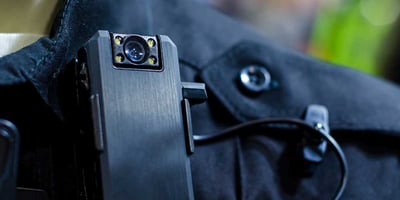Policies and Training are Critical to Effective Body-Worn Camera Usage
Posted on November 19, 2020 by Scott Neal
 The Chicago Sun-Times recently published a story that provides a cautionary tale that should be heeded by any law enforcement agency that is providing, or thinking of providing, body-worn cameras to its sworn officers.
The Chicago Sun-Times recently published a story that provides a cautionary tale that should be heeded by any law enforcement agency that is providing, or thinking of providing, body-worn cameras to its sworn officers.
On October 20, a police officer for a Chicago suburb pulled over a vehicle suspected of being in an earlier traffic crash. According to the newspaper story, the officer approached the vehicle and spoke with the occupants, who then allegedly sped off. The officer pursued and approached the vehicle a second time a short time later after it jumped a curb. This time, the occupants tried to flee again and put the vehicle into reverse, at which point it allegedly was moving toward the officer. The officer—who since has been fired for allegedly violating numerous department policies and procedures—then fired six shots into the vehicle, killing one of the occupants and injuring the other. The officer reportedly claimed that he “feared for his life.”
Here’s the problem, and the reason that I’m writing this blog: the officer reportedly failed to turn on his body-worn camera. The incident was captured by the officer’s in-vehicle camera system, as well as by private surveillance systems, but according to the story none of the footage clearly indicates how close the moving vehicle came to the officer. So, without the footage that the officer’s body-worn camera would have captured if it had been turned on, there is no way to determine whether the officer’s life truly was in danger. Could he have jumped out of the way? Sadly, we’ll never know.
It’s not clear what the police department’s policies or training procedures are regarding body-worn cameras. But that’s not what this blog is about. The moral of this story is that every agency that has or will implement this technology needs to craft well-conceived, thorough procedures that govern its use, and then repeatedly train officers on those procedures. One and done isn’t enough—repetition is the key to learning.
I’ll use a sports analogy to illustrate the point. A football team practices the same plays over and over, dozens and even hundreds of times. It’s boring for the players—but it is essential. The goal of this tedious exercise is to ensure that the players do what they’re supposed to do without needing to think about it. The movements essentially become instinctive, which tremendously reduces the chance of something going wrong.
It works the same with body-worn cameras, which absolutely are of no use if they are not turned on. Ideally, a holster sensor would trigger the body-worn camera anytime a weapon is cleared. But most agencies won’t have implemented that technology. So, officers need to be trained ad nauseam to ensure that they always engage their body-worn cameras instinctively. My suggestion is that they do so every time they leave their vehicles when responding to an incident, without fail.
In sharp contrast to the incident described above stands another incident that occurred in a different Chicago suburb just 11 days later. This time, again according to a Sun-Times account, the three officers involved in the shooting of a suspect were exonerated by the footage captured by their body cameras, although they remain on administrative leave as of this writing.
A whitepaper on body-worn cameras published by MCP (click here) cites a study released by the Bureau of Justice Statistics in November 2018. Of the agencies that had implemented such cameras, 74 percent indicated that a primary reason for doing so was to improve officer/agency accountability. In addition, 81 percent indicated that they wanted to reduce and/or resolve citizen complaints.
Another study conducted by a California police department in 2014 indicated that 60 percent fewer incidents of force and 88 percent fewer citizen complaints about officer misconduct were reported after body-worn cameras were issued to officers on all shifts.
Citizens are demanding more in-depth investigations into these types of incidents, as well as holding officers accountable if found to have improperly applied force. A step in the right direction is ensuring that officers use their body-worn cameras, and the keys to accomplishing that are well-conceived governance and well-executed training.
Please read the whitepaper, which contains many more insights regarding body-worn cameras. And please reach out to us—MCP has numerous subject matter experts who are extremely well-qualified and eager to help you procure the technology and guide you on developing the policies and procedures that will ensure its effective use.


